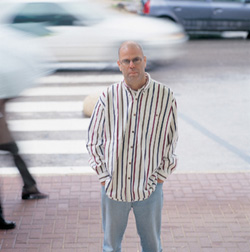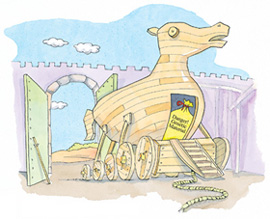Are you a journalist? Please sign up here for our press releases
Subscribe to our monthly newsletter:

Though one thousand warrior-filled ships were sent to the ancient city of Troy, the city's layout and impregnable walls saved it from conquest. The turning point, as related in Homer's Iliad, was the famous scheme devised by a shrewd Greek strategist.
The task of gene therapists is no less challenging. Armed with beneficial genes, the tools for the potential recovery of ailing patients, gene therapists must navigate them to the appropriate cells within a ten-trillion-cell body. The scientists then have to pass two barriers: They must smuggle the genes first into these cells, and then into the cell's inner sanctum, the nucleus, which houses the genetic material. Having tackled the first barrier, scientists are now pondering how to overcome the second. The nucleus's "walls"are lined with "sentries"that keep a watchful eye out for anything peculiar.
At first, viruses seemed well suited to the task because that is exactly what they have been doing for billions of years - penetrating the walls of the cell nuclei to maintain and propagate their genetic material. By replacing the harmful parts of their genetic material with genes intended to help treat a disease, scientists had hoped to use engineered viruses as delivery vehicles.
However, this method proved problematic: The viruses were sometimes toxic, induced immune and inflammatory responses, and even turned off healthy genes, including genes that suppress tumor growth. And as if that weren't enough, these engineered viruses sometimes underwent mutations that equipped them with additional damaging properties.
As a result, scientists began to experiment with synthetic systems, which are safer than viruses and provide better control. But while scientists could sneak DNA into the cell using these methods, they were usually unable to effectively transport DNA into the nucleus. Past attempts succeeded only in slipping an "unreadable,"and therefore ineffective, form of DNA into the nucleus. (DNA contains genes, which must be "read"to produce the proteins they encode.) And even those attempts were too costly to render gene therapy practicable.
This is where Dr. Ziv Reich of the Weizmann Institute's Biological Chemistry Department and his team came in. They crafted a method for smuggling DNA through the walls of the nucleus under the very noses of the cell's guardians. The method bears an uncanny resemblance to the Trojan horse.
There are two main routes into the nucleus. Molecules less than 8-9 nanometers (one nanometer is a billionth of a meter) in diameter can pass freely through its large pores. Larger molecules, however, must possess special "papers"- called nuclear localization signals (NLSs) - which DNA molecules, around 10 nanometers in diameter, don't carry.
To overcome this problem, Reich's team devised an approach in which DNA hitchhikes on a protein that does possess NLS. Reich modifies DNA to include specific binding sites for these proteins, which then transport the DNA into the nucleus, where it is "read."The bound proteins pose no obstacle to the reading process since their natural function is to bind to DNA inside the nucleus. Such modifications can be made readily, accurately, and inexpensively.
In addition, this study contains an unexpected twist. Since a variety of proteins in the cell possess NLS, Reich's group had to decide which family of proteins would play host to the hitchhiking DNA. "We chose the NFkB family,"says Reich, "because they bind strongly to DNA and are inducible, meaning that we can control their entry into the nucleus by sending special signals to the cell."
The NFkB family of proteins proved even more promising than anticipated. While Reich was studying their potential as DNA transportation vehicles, these proteins were discovered to play a central role in several autoimmune diseases, such as asthma and atherosclerosis, as well as in certain types of blood cancers - especially Hodgkin's disease, a common lymphoma. Whereas NFkB proteins normally enter the nucleus only when an appropriate signal is received, in Hodgkin's cells, they continually shuttle back and forth between the diseased cell's nucleus and its cytoplasm.
This distinction, believes Adi Mesika, one of Reich's doctoral students, could be used to induce Hodgkin's cells to destroythemselves. DNA that contains instructions for self-destruction could infiltrate the nucleus, piggybacking on aberrant NFkB proteins. Since NFkB proteins would not enter the nucleus of healthy cells, onlydiseased cells would self-destruct. This ability to preferentially destroy Hodgkin's cells will soon be investigated in collaboration with physicians on cells obtained from patients diagnosed with this disease.
In parallel to the NFkB approach, another of Reich's students, Saroj Shekhawat, is looking for other proteins that can do the job. The aim, explains Shekhawat, is to find proteins that are specific to certain tissues or organs, or proteins that are active in disease, allowing the targeting of DNA to ailing cells. "We are also looking for proteins that will condense the DNA, making it smaller and therefore easier to import through the nucleus's channels,"he says.
If successful, Reich's special delivery service might be an important factor in developing future gene therapies.

Dr. Reich's research is supported by the Levine Institute of Applied Science; the Clore Center for Biological Physics; the Kekst Family Center for Medical Genetics; the Avron-Wilstaetter Minerva Center for Research in Photosynthesis; the Molecular Imaging Corporation, Phoenix, AZ; Ms. Lois Rosen, Los Angeles, CA; and Teva Pharmaceuticals, Israel. He holds the Abraham and Jennie Fialkow Career Development Chair.